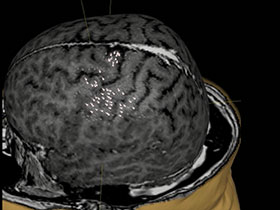NBS mapping for safer radiotherapy

For patients undergoing radiotherapy for brain metastases, it is important to preserve the quality of life after a course of therapy. Brain mapping with Nexstim nTMS technology NBS allows the radiotherapist to modify the dose plan in order to minimize undesired dosing of areas in the brain which need to be preserved.
Ionizing radiation is effective in treating tumor tissue because it damages the cells, slowing growth of the tumor—and at high doses can cause the cancerous cells to die.
However, the radiation beams can also cause undesirable toxicity to other, essential areas of the brain.
Unlike in surgery, with radiotherapy there is no way to know where the individual’s vital motor areas are located unless brain mapping is used prior to the radiotherapy.
Valuable New Tool for Radiotherapy
Brain mapping with Nexstim nTMS technology NBS accurately defines the areas in the brain responsible for motor function—without removing part of the skull. The NBS information allows the radiotherapist to modify the dose plan in order to minimize undesired dosing of vital areas which need to be preserved. High doses of radiation are associated with cell death and can also lead to a deterioration in motor function after therapy.
Studies have shown that using nTMS to guide the orientation of the radiation beam allows for significantly reduced dosing to motor areas (-18.1%), without compromising treatment of the tumors.*
As a non-invasive method, NBS mapping is a valuable new tool for radiotherapists. NBS complements the use of non-surgical (non-invasive) treatment. For the first time, radiotherapists now have the ability to accurately and reliably modify dosing to potentially help to preserve motor function and thus the quality of life of their patients.
*Schwendner, MJ. et al. The Role of Navigated Transcranial Magnetic Stimulation Motor Mapping in Adjuvant Radiotherapy Planning in Patients With Supratentorial Brain Metastases. Front Oncol. 2018 Oct 2;8:424.
Mapping Motor Function

Indications for Use and Safety
INTENDED PURPOSE & INDICATIONS FOR USE
Intended purpose: NBS 6 is intended to be used for localization and assessment of the motor cortex and motor tract integrity for pre-procedural planning purposes. NBS 6 is intended to be used for localization and assessment of cortical areas of speech function for pre-procedural planning purposes.
Indications for use: NBS 6 is indicated for noninvasive mapping of the primary motor cortex of the brain to its cortical gyrus. NBS 6 provides information that may be used in the assessment of the primary motor cortex for pre-procedural planning. NBS 6 is indicated for noninvasive localizations of cortical areas that do not contain essential speech function. NBS 6 provides information that may be used in pre-surgical planning in patients undergoing brain surgery. Intraoperatively, the localization information provided by NBS 6 is intended to be verified by direct cortical stimulation. NBS 6 is not intended to be used during a surgical procedure. NBS 6 is intended to be used by trained clinical professionals.
Contraindications
Do not use the Nexstim NBS System on:
- persons who have metallic implants anywhere in the head (excluding teeth)
- persons who have any electrical implants
- persons with increased intracranial pressure
- persons with intracardiac lines, intravenous pumps, or dose calculators.
Do not use the Nexstim NBS System without clear benefit or compelling clinical reason on:
- persons with epilepsy
- persons with serious heart disease
- persons with lowered seizure threshold due to acute large infarctions, intracranial hemorrhage, or trauma
- persons with medication that lowers the seizure threshold
- persons with cardiac pacemaker.
Women of childbearing age must be questioned about the possibility of pregnancy before participating, and excluded—if there is a chance that they may be pregnant. Women of childbearing age should not participate without clinical reason.
Risk of seizures
Cortical magnetic stimulation runs the risk of inducing seizures - although they are rare. Single-pulse TMS, which is used in mapping the cortical representation areas of specific muscles, is generally considered a non-significant risk application. However, secondarily generalized or partial motor seizures have been induced in patients with stroke, intracranial brain lesions and major disorders of the central nervous system. The seizures have occurred either during the TMS stimulation or minutes after the end of the stimulation session.
